Blank Cafc201 Missouri Form
The CAFC201 Missouri form is a legal document used to petition for child custody in the state of Missouri. This form requires detailed information about the petitioner, the other party involved, and the children affected by the custody arrangement. Completing this form accurately is essential for ensuring that the court can make informed decisions regarding the custody of the children involved.
To begin the process of filing your petition for child custody, please fill out the form by clicking the button below.
Access Cafc201 Missouri Editor
